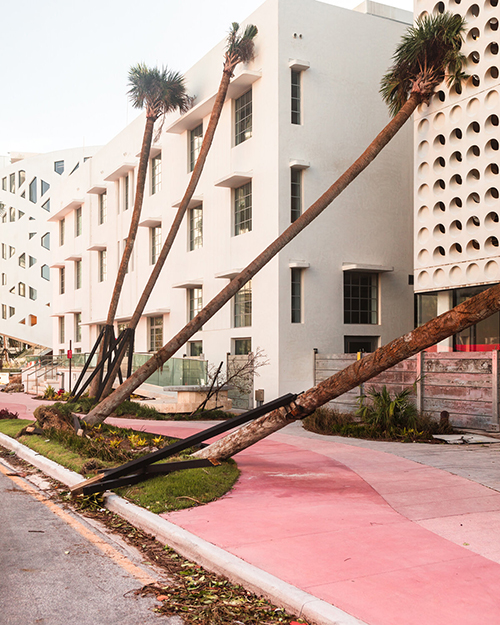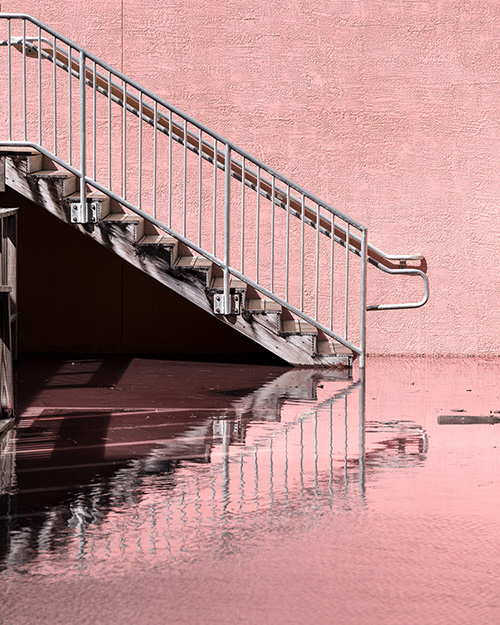
ROBERT ROWE
A book of her eerily serene yet troubling photographs titled FloodZone (Steidl, 2019) depicts a beautiful but unsettling vision of Miami’s superficial glitz amid the implacable rise in sea levels. A second book, titled Floridas, is scheduled for publication in March 2022.
Her photographs have been featured in solo and group exhibitions in Amsterdam, Berlin, Frankfurt, Madrid, Moscow, Vienna, New York and Miami and have received critical praise from top curators and critics. Sarah Rosen, of the online publication Document Journal, writes, “Lush, beautiful and seductive, Samoylova’s photographs … are subversive images of paradise, glossy and sleek, subtly revealing something hellish lurking just beneath the surface.”
Samoylova earned a master’s degree in architecture and environmental design in her native Moscow and a Master of Fine Arts degree from Bradley University in 2011. She taught photography at Illinois Central College and Bard College before moving to Miami in 2016.
FloodZone presents a carefully edited collection of 87 photographs made in and around Miami, Fla., which Samoylova describes as “ground zero for sea-level rise.” Rather than presenting scenes of devastation, each image is precisely composed and hauntingly beautiful. While water is a recurring theme throughout the book, these are not typical beachfront scenes. Water creeps in ominously, sometimes in places where water should not be. Through Samoylova’s lens, water becomes a thin shimmering surface on a fine mosaic floor or rippling reflections on otherwise solid walls.

“Fallen Trees on Collins Ave., Miami Beach Sidewalk after Hurricane Irma” by Anastasia Samoylova. (SUBMITTED PHOTO)
A distinctive color palette pervades the images in FloodZone. Pastel pinks and yellows signify the tropical tourist paradise, while nature asserts itself in saturated greens and blues. The insistent cheerfulness of the iconic pink sidewalk of Miami Beach contrasts with a neat row of storm-toppled palm trees. Reflections in shop windows or large commercial banners of the sort used to screen ongoing construction sites create disconcerting spatial anomalies, contributing to the general feeling of dissociation and alluding to the anxiety of living in a state of partial denial. While these images are straight camera photographs, some of the recurring compositional devices, such as photographs within photographs, reference some of Samoylova’s earlier work that made brilliant use of constructivist-inspired assemblages.
In her new book, Floridas, Samoylova presents a wistful and insightful view of the less-traveled parts of Florida, particularly the interior and northwest coast. She revisits some of the locations photographed by one of her photographic heroes, Walker Evans, who is perhaps best known for his famous Depression-era images of the rural South, photographed extensively in Florida from the 1930s to the 1970s. Samoylova’s and Evans’ photographs are cleverly paired throughout the book, effectively opening up the fourth dimension — time.
The overt environmental message of Floridas is integrated into a starker vision that reminds us of the disparity between the vacation paradise and the realities such as income inequality, wastefulness and neglect that lie beneath this supposed paradise. The book also contains a text by David Campany, curator, writer, and managing director of programs at the International Center of Photography, and short fiction by novelist Lauren Groff.
Readers of this column might ask what this has to do with “Inland Art.”
We who live in the Midwest are inextricably tied to Florida and the Gulf Coast. The river that flows through Peoria empties into the Gulf and washes the shores of Florida and other gulf states. Perhaps equally significant, much of the material culture of Florida, as we know it, was created as an escape for people from the Midwest and Northeast. It was constructed, however, on top of a fragile and threatened ecosystem. In the dialectic between the veneer of man-made structures and the irrepressible forces of nature that encroach and erode them, Samoylova remains agnostic as to which side will prevail.
Current and past photographic projects by Anastasia Samoylova can be found at www.anasamoylova.com.

“Staircase at King Tide, Hollywood,” 2019 by Anastasia Samoylova. This photo and the adjacent “Fallen Trees on Collins Ave., Miami Beach Sidewalk after Hurricane Irma” can be found in the photo book entitled Floodzone by Samoylova. (SUBMITTED PHOTO)
